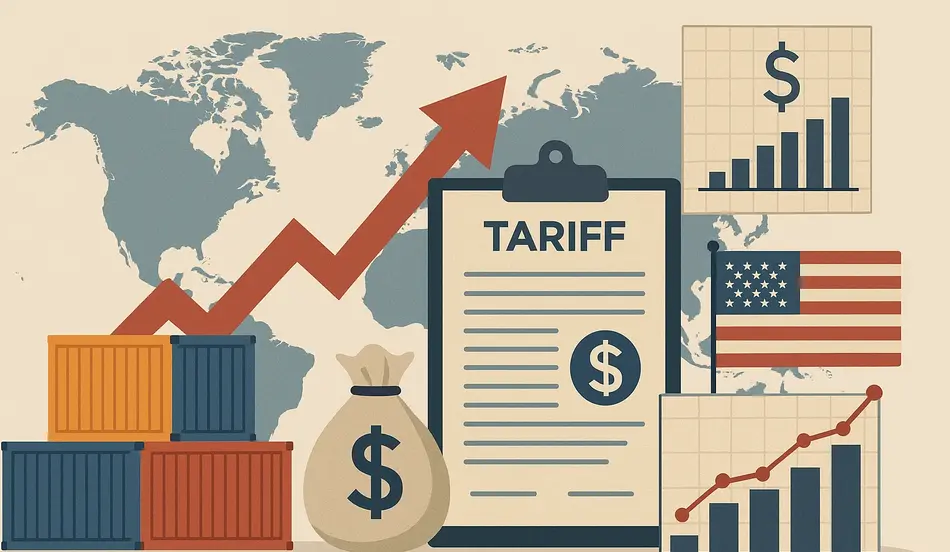Introduction: US Tariff Revenue and the Trump Trade Era
US tariff revenue has become a central topic in global economic discussions, especially since the implementation of President Trump’s aggressive trade policies. As the US government collects billions in tariffs, the effects ripple through international commerce, impacting importers, consumers, and the broader economy. This article explores the surge in US tariff revenue, the mechanics of Trump’s trade policies, and the far-reaching consequences for global trade.
US Tariff Revenue Growth: Billions Collected
Since 2018, the US has seen a dramatic increase in tariff revenue, with billions of dollars flowing into federal coffers. According to the US Customs and Border Protection, tariff collections have more than doubled compared to pre-2018 levels. This surge is directly linked to new tariffs imposed on goods from China, the European Union, and other trading partners. The focus keyphrase, US tariff revenue, is now synonymous with the Trump administration’s approach to trade enforcement and economic leverage.
Trump’s Trade Policies: The Strategy Behind the Tariffs
President Trump’s trade policies were designed to protect American industries and reduce the trade deficit. By imposing tariffs on a wide range of imported goods, the administration aimed to encourage domestic production and penalize countries accused of unfair trade practices. The Brookings Institution provides a comprehensive analysis of these strategies, highlighting both their intended and unintended effects. The result has been a significant increase in US tariff revenue, but also heightened tensions with key trading partners.
Impact on Importers: Navigating Higher Costs
Importers have been among the most directly affected by the surge in US tariff revenue. Companies that rely on foreign goods face higher costs, which are often passed on to consumers. For example, electronics, machinery, and textiles have all seen price increases due to tariffs. Many importers have had to adjust their supply chains, seek alternative suppliers, or absorb losses to remain competitive. For more insights on how tariffs affect job markets, visit US Dollar Weakness: How Currency Devaluation Will Reshape the Job Market for American Workers on WhatJobs.
Consumer Impact: Rising Prices and Shifting Choices
Consumers ultimately bear much of the burden from increased US tariff revenue. As importers raise prices to offset tariff costs, everyday goods become more expensive. This has led to changes in consumer behavior, with some opting for domestic alternatives or delaying purchases. The economic impact is particularly pronounced in sectors like electronics, apparel, and automobiles. For a deeper dive into consumer trends, see Consumer Behavior on WhatJobs.
Port Operations: Managing the Tariff Surge
US ports have experienced significant operational changes due to the increase in tariffed goods. Customs processing times have lengthened, and there is greater scrutiny of shipments subject to new tariffs. Port authorities have had to invest in additional resources to manage the higher volume of tariff collections and compliance checks. This has created both challenges and opportunities for logistics providers and port workers. For more on employment trends in logistics, check out Employment News on WhatJobs.
Post Your Job on WhatJobs
Looking to hire top talent in a changing economic landscape? Post your job on WhatJobs today and connect with qualified candidates across the globe — free for 30 days.
Post a Job Free for 30 Days →Legal Challenges: Contesting the Tariffs
The surge in US tariff revenue has not gone unchallenged. Numerous lawsuits have been filed by importers, trade associations, and foreign governments, contesting the legality of certain tariffs. Courts have issued mixed rulings, with some tariffs upheld and others struck down. The legal landscape remains complex, and ongoing litigation continues to shape the future of US trade policy.
Economic Implications: Winners and Losers
While US tariff revenue has provided a short-term boost to government finances, the broader economic implications are mixed. Some domestic industries have benefited from reduced foreign competition, while others have struggled with higher input costs. The overall impact on GDP, employment, and inflation remains a subject of debate among economists. The long-term effects of Trump’s trade policies will depend on future negotiations and the global response to US tariffs.
FAQs: US Tariff Revenue
What is US tariff revenue?
US tariff revenue refers to the money collected by the US government from taxes imposed on imported goods. These tariffs are designed to protect domestic industries and generate government income.
How have Trump’s trade policies affected US tariff revenue?
Trump’s trade policies significantly increased US tariff revenue by imposing new tariffs on goods from China and other countries, leading to billions in additional collections.
Who pays for US tariffs?
Importers are responsible for paying US tariffs, but the costs are often passed on to consumers through higher prices on imported goods.
What are the economic implications of higher US tariff revenue?
Higher US tariff revenue can benefit some domestic industries but may also lead to increased costs for businesses and consumers, affecting overall economic growth.
How do legal challenges impact US tariff revenue?
Legal challenges can result in some tariffs being overturned, which may reduce US tariff revenue and alter the trade landscape.
Importer’s Perspective
Consider the case of a US-based electronics importer who sources components from China. Following the implementation of new tariffs, the company saw its costs rise by 15%. To remain competitive, the importer had to renegotiate contracts, seek alternative suppliers in Southeast Asia, and pass some of the increased costs onto customers. Despite these efforts, profit margins shrank, and the company had to delay expansion plans. This real-world example illustrates how US tariff revenue growth, driven by Trump’s trade policies, directly impacts business decisions and the broader economy.
Conclusion: The Future of US Tariff Revenue
US tariff revenue will continue to be a key indicator of trade policy effectiveness and economic health. As legal battles unfold and global commerce adapts, businesses and consumers alike must stay informed about the evolving landscape. For the latest updates on employment and economic trends, visit WhatJobs regularly.




